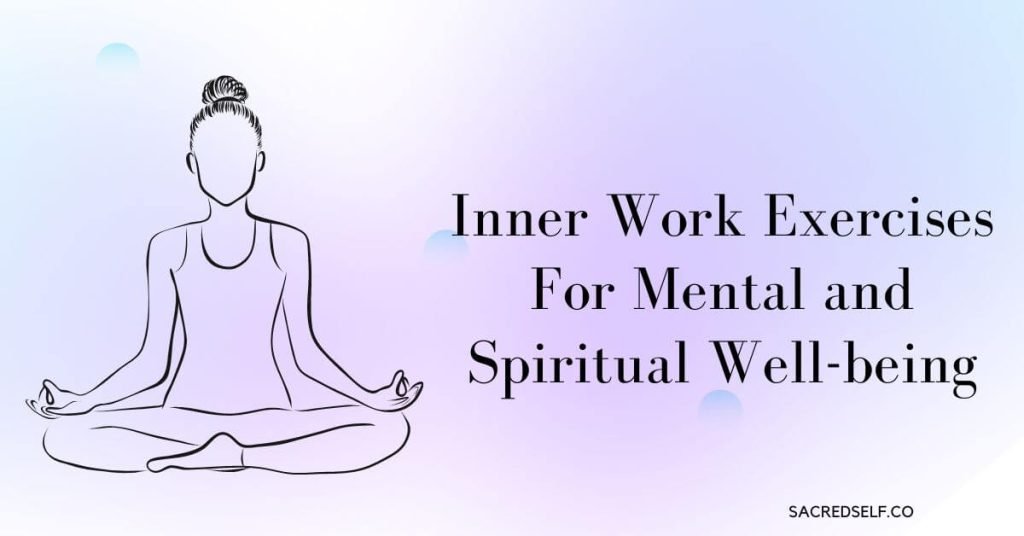This post may contain affiliate links.
Deep breath…
Let us begin this article on inner work exercises with a calm and centered mind. Inner work, also known as soul care exercises, is the practice of looking within oneself to promote personal growth and spiritual development.
In today’s fast-paced world, where external distractions can easily get us, it is crucial to carve out time for spiritual exercises in everyday life. As a practitioner of inner work exercises, I can attest to the power of these practices to cultivate a deep sense of spiritual strength and resilience.
What is Inner Work Exercises?
At its core, inner work exercises involve a journey of self-discovery, which is a process of delving deep into one’s psyche to explore emotions, beliefs, and values.
These exercises can take many forms, from spiritual breathing and visualization to shadow work techniques or exercises for shadow work.
Inner work exercises can be both challenging and transformative, requiring a willingness to confront and integrate our shadow selves. But the benefits of engaging in this practice are immeasurable – they can lead to improved emotional regulation, reduced stress and anxiety, and a greater sense of purpose and fulfillment in life.
As such, it is important to understand the best inner work exercises for beginners to start on this rewarding path of self-discovery.
As a practitioner and teacher of these exercises, I can attest to their potency and life-changing effects. The following sections will explore the different types of inner work exercises and how they can be incorporated into daily life to promote holistic well-being.

Types of Inner Work Exercises
Let’s dive straight into the different types of inner work exercises that can help us cultivate a deeper sense of self-awareness and connection to our inner being.
1. Mindfulness and Meditation
The classic spiritual practice that has been around for centuries. Mindfulness and meditation are two sides of the same coin, both helping us to develop a greater sense of presence and awareness in the present moment. Whether you choose to sit quietly and focus on your breath or use a guided meditation app, this practice can be a powerful tool for inner work.
In my daily inner work type of exercises, I go to Sadhguru’s meditation called Isha Kriya. You can give this a try if you want something easy and that actually works!
2. Journaling
For those of us who like to get our thoughts and feelings down on paper, journaling is a powerful way to process and reflect on our inner world. It’s a safe space to explore our emotions, identify patterns, and gain deeper insight into our thoughts and behaviors.
There are several studies done on the positive effects of journaling. But this one study has shown regular journaling wherein subjects were answering questions such as What are you thankful for? What did someone else do for you? was associated with decreased mental distress, increased well-being, and a decrease in symptoms of depression and anxiety.
3. Shadow Work
Shadow work involves diving deep into the parts of ourselves that we may not be comfortable with, the parts that we try to ignore or suppress. Through shadow work techniques and exercises, we can shine a light on these parts of ourselves and integrate them into our whole being.
At its core, shadow work is about bringing forth parts of our subconscious self into the subconscious. There are sub-personalities in our psyche that have been silenced from a young age.
Some of these are better off staying in the shadow as you don’t want every past impulse to be finding expression now. Even so it’s good to be aware of them.
Whilst these can be done by oneself, shadow work is not for the faint-hearted, and professional help in the form of therapy may be best for most people.
But some of these sub-personalities are part of our true selves and they can complete us when setting them free into the conscious and integrating them into our personality.
4. Visualization
Visualization is a powerful tool for manifestation and creating the life we want to live. Through visualizing our goals and desires, we can tap into the power of our subconscious mind to bring them into reality. This practice can also be used for inner work, as we can visualize ourselves as the best version of ourselves, tapping into our true potential.
As the old saying goes, your brain has a hard time distinguishing what is real from what is imagined. If you are still not sure if visualization works, check out this article on Psychology Today that speaks about the power of visualization from a scientific perspective.
If you want an easy start on this inner exercise technique, I will again recommend something from our beloved Sadhguru – Chit Shakti Meditation for Health, Love, Sucess, and Peace.
5. Gratitude Practice
Last but not least, we have the practice of gratitude. When we focus on the things we are grateful for, we shift our energy to a positive and abundant mindset. This practice can help us to cultivate more joy, appreciation, and connection in our lives.
But this is easier said than done as when you are in a negative mindset when things seem to go around us we easily fall into the trap of entitlement.
No advice can be said here that will surely work for anyone.
But remember this: no matter how bad you have it, there is at least someone else who is having it at least a little worse than you have it. And also remember that all adversity can either break us or make us.
There are actually studies done on the positive effects of gratitude. You can easily find anywhere online people that attest to the power of focusing on what you have against what you want to have but don’t.
6. Chakra Healing
You can also invest time into learning about chakras and see where you stand in relation to chakra blockages and symptoms. Then you can patiently work towards balancing your chakras using the various techniques and tools as a form of inner work exercise to help heal yourself from the inside.
Now, these are just a few examples of the vast array of inner work exercises out there. So don’t be afraid to experiment and find what works best for you. The key is to incorporate spiritual exercises in everyday life, making them a part of your daily routine and soul-care exercises.
Let’s face it, finding time for inner work exercises in our busy lives can be a challenge. However, by integrating these practices into our daily routines, we can make them a part of our daily lives without feeling overwhelmed.
Here are some tips on how to make inner work exercises a regular part of your routine:
1. Setting Aside Time for Inner Work
Schedule a specific time each day to practice inner work exercises. Whether it’s first thing in the morning, during lunch, or before bed, setting aside time will help you create a consistent routine.
2. Finding the Right Exercise for Your Needs
There are many types of inner work exercises, and not all of them will resonate with everyone. Experiment with different practices and find the ones that work best for you.
3. Developing a Consistent Practice
Consistency is key when it comes to inner work exercises. Start small and gradually increase the time you spend on each practice. By making inner work a regular part of your routine, you’ll begin to see the benefits.
Benefits of Inner Work Exercises
Now that we’ve covered some of the ways to incorporate inner work exercises into your daily life, let’s talk about the benefits. Here are just a few of the many benefits of practicing inner work exercises:
1. Increased Self-Awareness and Understanding
Through practices like journaling and mindfulness, we can begin to understand our thoughts and emotions on a deeper level. This self-awareness can lead to greater understanding and compassion for ourselves and others.
2. Improved Emotional Regulation
By practicing inner work exercises, we can learn to regulate our emotions more effectively. This can help us cope with stress and anxiety and lead to greater emotional stability.
3. Reduced Stress and Anxiety
Inner work exercises like meditation and breathing exercises have been shown to reduce stress and anxiety levels. These practices help to calm the mind and promote relaxation.
4. Greater Sense of Purpose and Fulfillment
As we become more self-aware and connected to our inner selves, we may begin to discover our passions and purpose in life. This can lead to a greater sense of fulfillment and satisfaction.
So there you have it, spiritual seekers!
Incorporating inner work exercises into your daily routine can have profound benefits for your mind, body, and soul. So why not give it a try? Start small, be consistent, and enjoy the journey toward greater self-awareness and spiritual growth.
Conclusion
As I conclude this on the benefits of inner work exercises, it’s important to note that this is a journey that requires commitment, patience, and perseverance. Through inner work exercises, we can tap into the innermost aspects of our being, nurture our spiritual growth, and improve our overall well-being.
By integrating these exercises into everyday life, you can maintain a state of balance and harmony in your life.
And when we face our shadows and engage in shadow work techniques, we are empowered to heal and transform ourselves, thus attaining greater spiritual strength and training.
If you have anything to share that might help you or others, don’t hesitate to use the comments section below.

